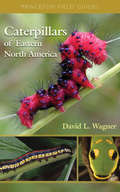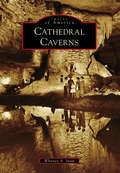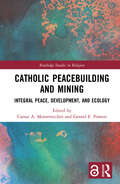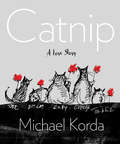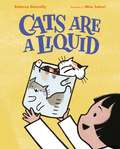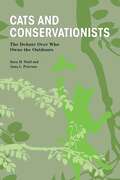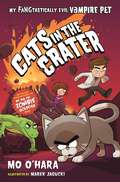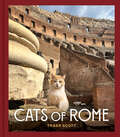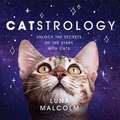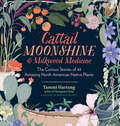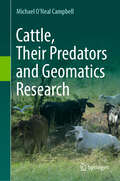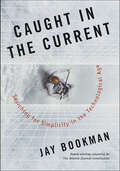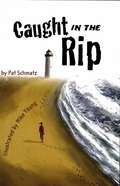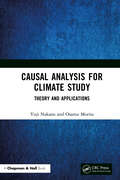- Table View
- List View
Caterpillars of Eastern North America: A Guide to Identification and Natural History (Princeton Field Guides #36)
by David WagnerThis lavishly illustrated guide will enable you to identify the caterpillars of nearly 700 butterflies and moths found east of the Mississippi. The more than 1,200 color photographs and two dozen line drawings include numerous exceptionally striking images. The giant silk moths, tiger moths, and many other species covered include forest pests, common garden guests, economically important species, and of course, the Mescal Worm and Mexican Jumping Bean caterpillars. Full-page species accounts cover almost 400 species, with up to six images per species including an image of the adult plus succinct text with information on distribution, seasonal activity, foodplants, and life history. These accounts are generously complemented with additional images of earlier instars, closely related species, noteworthy behaviors, and other intriguing aspects of caterpillar biology. Many caterpillars are illustrated here for the first time. Dozens of new foodplant records are presented and erroneous records are corrected. The book provides considerable information on the distribution, biology, and taxonomy of caterpillars beyond that available in other popular works on Eastern butterflies and moths. The introductory chapter covers caterpillar structure, life cycles, rearing, natural enemies, photography, and conservation. The section titled "Caterpillar Projects" will be of special interest to educators. Given the dearth of accessible guides on the identification and natural history of caterpillars, Caterpillars of Eastern North America is a must for entomologists and museum curators, forest managers, conservation biologists and others who seek a compact, easy-to-use guide to the caterpillars of this vast region. A compact guide to nearly 700 caterpillars east of the Mississippi, from forest pests to garden guests and economically important species 1,200 color photos and 24 line drawings enable easy identification Full-page species accounts with image of adult insect for almost 400 species, plus succinct text on distribution and other vital information Many caterpillars illustrated here for the first time Current information on distribution, biology, and taxonomy not found in other popular works A section geared toward educators, "Caterpillar Projects" An indispensable resource for all who seek an easy-to-use guide to the caterpillars of this vast region
Catfish Ponds & Lily Pads: Creating and Enjoying a Family Pond
by Louise RiotteIn this entertaining guide, Louise Riotte tells you everything you need to know to create a productive pond on your own land, from siting the pond to maintaining water quality and stocking the pond with fish. She also includes plenty of old-time fishing lore and scrumptious recipes for freshly caught fish.
Cathedral Caverns (Images of America)
by Whitney A. SnowIn 1952, Jacob “Jay” Gurley explored a Marshall County, Alabama, curiosity known as Bat Cave. Amazed by its stalagmites and sheer enormity, he purchased the site and began transforming it into Cathedral Caverns, a spectacular tourist attraction that eventually became a national natural landmark in 1973 and a state park in 2000. Had it not been for Gurley’s hard work and dedication, this cave, a geological treasure of international renown, might have remained a little-known hole in the ground. His efforts impacted local and state tourism, economics, and politics. This is the story of one man and his vision.
Catholic Peacebuilding and Mining: Integral Peace, Development, and Ecology (Routledge Studies in Religion)
by Caesar A. MontevecchioThis book explores the role of Catholic peacebuilding in addressing the global mining industry. Mining is intimately linked to issues of conflict, human rights, sustainable development, governance, and environmental justice. As an institution of significant scope and scale with a large network of actors at all levels and substantial theoretical and ethical resources, the Catholic Church is well positioned to acknowledge the essential role of mining, while challenging unethical and harmful practices, and promoting integral peace, development, and ecology. Drawing together theology, ethics, and praxis, the volume reflects the diversity of Catholic action on mining and the importance of an integrated approach. It includes contributions by an international and interdisciplinary range of scholars and practitioners. They examine Catholic action on mining in El Salvador, Peru, Colombia, the Democratic Republic of the Congo, and the Philippines. They also address general issues of corporate social responsibility, human rights, development, ecology, and peacebuilding. The book will be of interest to scholars of theology, social ethics, and Catholic studies as well as those specializing in development, ecology, human rights, and peace studies.
Catnip: A Love Story
by Michael KordaFrom silly to sweet, 365 cat sketches by Michael Korda, drawn with love for his wife With the imagination of a writer and the eye of an artist, Michael Korda doodled on the backs of old manuscripts in his tackroom while his wife, Margaret, was out riding. They loved and acquired cats—a habit written about previously in their book, Cat People—and the few in residence at this time would serve as inspiration for the drawings. These are no ordinary cat illustrations, though. Korda’s cats read newspapers and books; go ice skating in the small country town where they live; comfort Margaret’s horse, Monty, after a stressful vet visit; sell fried mice at the Farmer’s Market, and undertake (on paper, at least) whatever fanciful endeavors their keeper conjures up. The result is a collection of magical pieces, filled with joy, that represent a year in the life of a couple in love with one another, and certainly with their cats.
Cats Are a Liquid
by Rebecca DonnellyCelebrate cats in all their flowing, furry glory in Cats Are a Liquid, a charming picture book that examines the unusual physical properties of felines by writer Rebecca Donnelly and illustrator Misa Saburi.Cats fill./ Cats spill./ Cats flow downhill.// Cats tip./ Cats drip./ Cats grip, snip, rip.// Cats are a liquid/ Except when they’re not.Inspired by an Ig Nobel Prize–winning investigation of how cats behave like liquids, this book introduces some of the physical properties of liquids—they adapt to fit a container, they flow like fluids—and is just pure fun. Like its inspiration, it makes you laugh, then think. Back matter includes a brief introduction to the different physical states: solid, liquid, gas.
Cats Will Be Cats: The Ultimate Cat Quotebook
by Brooke JordenWith quotes from cat-lovers and cat-toleraters alike, Cats Will Be Cats is a new kind of quote book about what these feline friends and fiends bring to our lives.
Cats and Conservationists: The Debate Over Who Owns the Outdoors (New Directions in the Human-Animal Bond)
by Anna L. Peterson Dara M. WaldCats and Conservationists is the first multidisciplinary analysis of the heated debate about free-roaming cats. The debate pits conservationists against cat lovers, who disagree both on the ecological damage caused by the cats and the best way to manage them. An impassioned and spirited conflict, it also sheds light on larger questions about how we interpret science, incorporate diverse perspectives, and balance competing values in order to encourage constructive dialogue on contentious social and environmental issues. <p><p>On one side of the cat debate stand many environmentalists, especially birders and conservation organizations, who believe that outdoor cats seriously threaten native wildlife. On the other side are many animal welfare advocates, who believe that outdoor cats generally do not pose a major ecological threat and that it is possible for cats and wildlife to coexist. They believe that it is possible, mainly through trap-neuter-return projects (TNR), to keep free-roaming cat populations in check without killing large numbers of cats. <p><p>Careful analysis suggests that there remain important questions about the science on both cat predation and TNR effectiveness. Yet both sides of the conflict insist that the evidence is clear-cut. This false certainty contributes to conflict between conservationists and cat lovers, and obscures common goals that could generate constructive discussions and collaborative efforts among scientists, policymakers, conservationists, and animal welfare advocates. Cats and Conservationists aims to facilitate such collaboration in order to manage outdoor cats and minimize the damage they cause. It also offers models for constructive debates about the public role of science in other polarized public conflicts over science and environmental topics.
Cats in Hats
by Kat ScratchingJazz cats in fedoras, feisty cats in Viking horns, gourmand cats in chef’s hats, Burmese cats in bonnets, and the always popular Siamese in a sombrero—no one rocks a hat quite like a cat.Featuring more than forty two-page spreads consisting of color photos alongside hilarious captions and informative text, Cats in Hats is a fun, joyful compendium of some exquisite combinations of felines and head wear. They say cats have nine lives, but no one’s ever told us how many hats they have...
Cats in Origami
by Nick RobinsonTwenty projects feature cats in various poses, from a grinning Cheshire cat to walking and sleepy felines. Includes step-by-step instructions, illustrated with color photos and diagrams.
Cats in Pop Culture
by Stéphanie Chaptal Claire-France ThévenonThis definitive history of cats depicted in iconic movies, books, TV series, comics, and other works of art, complete with interviews from cat experts and colorful illustrations, is sure to delight both fans of pop culture and anyone who loves our furry feline friends.From Garfield to Catwoman, to everything in between, cats occupy a special space in our lives. This definitive guide walks you through a host of pop culture&’s most iconic cats across a wide span of genres, including anime, horror, fantasy, comedy, sci-fi, drama, and children&’s stories. Enjoy interviews from cat experts and standalone sections on the myth and mystique of cat lore, all accompanied by stunning illustrations of favorite felines characters. BELOVED CHARACTERS Cats appearing in everything from James Bond films to Hello Kitty strut down the catwalk and have their moment in the spotlight in this genre-spanning work. CAT LORE Self-contained features examine many aspects of cat lore and how they have been represented in popular culture. EXPERT INSIGHTS Level up your cat knowledge with interviews with cat experts and specialists, including zoologist Cécile Callou, physicist Renaud Guillemin, and digital strategist Fabien Loszach, who offer unique insights from their own professional specialism. GORGEOUS ILLUSTRATIONS Colorful kitty images from novels, comics, film posters, and classical artwork illustrate this guide.
Cats in the Crater: My FANGtastically Evil Vampire Pet (My FANGtastically Evil Vampire Pet #3)
by Mo O'HaraIn Cats in the Crater: My FANGtastically Evil Vampire Pet, the third in the spin-off series to Mo O'Hara's New York Times bestselling My Big Fat Zombie Goldfish chapter books, an aspiring evil scientist and his mostly evil (and totally forbidden) vampire kitten must face a trap-filled Volcanic Lair at Evil Scientist Summer Camp.Welcome back to Camp Mwhaaa-haa-ha-a-watha!My epic summer at Evil Scientist Summer Camp hasn't gone quite like I planned, but THIS week I will DEFINITELY be Evil Emperor of the Camp. I've been stocking up on evil inventions and Fang's been sharpening her claws. We're ready for anything!Okay, so maybe I wasn't really prepared to find out that Geeky Girl's grandmother is actually Madame Mako, inventor of the original volcano lair, and ruler of the most famous evil empire ever . . . but, this is going to be GREAT. Geeky Girl can inherit her grandmother's empire, and I'll come in as Head Partner, and help teach her the best way to be an evil ruler—with an epically evil crown!Let our Epic Evil Empire begin!Signed,The Great and Powerful MarkFeaturing illustrations by Marek Jagucki
Cats of Rome
by Traer ScottFrom the award-winning author of Finding Home and Rescue Cats: a dazzling collection of photographs of cats throughout the iconic city of Rome.Whether you are a cat lover, armchair traveler, or photography buff, Traer Scott’s Cats of Rome will entice you into this ancient city that is home to more than 300,000 cats. Of these, at least one-third are thought to be feral. As Roman cats are protected by law, they have the right to live where they choose in architectural ruins, parks, and neighborhoods throughout the city.In seventy-five brilliant color photographs, Rome’s feline denizens are shown as they live naturally among stunning, classical backdrops, with visual whispers of the gattaras—the often nameless and plentiful women of Rome who volunteer to care for the feral colonies. These beautiful cats are safe, cared for, and magnificent, and this keepsake volume is perfect for anyone who has visited Rome or dreams of doing so.CELEBRATED PHOTOGRAPHER: Traer Scott, award-winning photographer and animal welfare activist, turned her lens on the cats of Rome as she explored the Eternal City and sought out evidence of its estimated four thousand feral cat colonies. Through her practiced lens, these majestic felines and their breathtaking surroundings—from the Colosseum to lush cemeteries to the ruins of Porta Magica—create an irresistible travelogue for cat lovers and travel enthusiasts alike. Scott’s bestselling animal photography books include Forever Home, Radiant, and Shelter Dogs.CAT COFFEE TABLE BOOK: Several children’s books feature the wondrous cats of Rome, but this is the first photography book to showcase the beloved cat sanctuaries of this historic and uniquely beautiful European city.ITALIAN HISTORY: Each chapter showcases one of Rome’s vibrant cat colonies, with introductory text about the location, a brief bit of history, and an overview of the cat population’s roots within it. From ancient to modern Rome, this artful book offers a visual journey through a mesmerizing place.Perfect for:Cat lovers and collectors of cat photographyTravelers and armchair travelersFans of Italian culture, history, and architectureReaders who enjoy nature, animal, and travel coffee table books
Cats of the World
by Hannah Shaw Andrew MarttilaAn Instant New York Times Bestseller. Hannah“Kitten Lady” Shaw and professional cat photographer Andrew Marttila journey to thirty countries to bring you hundreds of photos and stories of cats from every corner of the world. Wife and husband team Hannah Shaw and Andrew Marttila have made cats their lives' work: they rescue and rehabilitate neonatal kittens, educate the public on cat and kitten care, and capture our feline friends' unique personalities through writing and photography. Now, in the project of their dreams, they've taken their passion for cats global. In Cats of the World, Shaw and Marttila travel across thirty countries to explore feline welfare and cat culture around the globe, documenting their travels with stunning photos and stories from each location. Journey to England's charming pubs and candle-lit cathedrals, Chile&’s vibrant produce markets and colorful hillsides, Türkiye&’s spice bazaars and ancient ruins, South Africa's bustling streets and lush mountains, and so many places in between with Shaw and Marttila as they learn from cats—and the people who love them most—that compassion is truly a universal language. <br><b>New York Times Bestseller</b></br>
Cats on Catnip
by Andrew MarttilaA humorous collection of dozens of photos of funny and adorable cats as they play with, roll in, and chow down their favorite snack of choice -- catnip. Cats love catnip. Whether it's eating it, playing with it, or rolling around in it, catnip turns our domestic feline friends into hilarious balls of activity. Carefree and unconstrained, they are free to be silly, exceptionally playful, and downright gnarly. Professional pet photographer and self-confessed crazy cat man Andrew Marttila (the photographer behind Shop Cats of New York) captures a range of the cats' silly and expressive personalities as they react to their catnip trip. Delightful, elegant Fluffy transforms into a hell-bent renegade. Shy, reserved Mittens becomes a free-loving acrobat. In the blink of an eye, a cat's expression transforms from bored to inquisitive to playful to curious to bizarre . . . to utterly unhinged. A fun and delightful look at our furry companions, this gift book is perfect for every cat lover.
Cats on Instagram
by @cats_of_instagramFrom the popular Instagram profile comes this collection of adorable cat photos to warm the hearts of cat lovers everywhere.Cat lovers, rejoice! This irresistible book compiles more than four hundred photos from the hugely popular Instagram profile @cats_of_instagram into a keepsake treasure. Playful categories including “bowties,” “surprise!,” and “happy cats” showcase all the charm and delightful quirks of the wide world of cats. This is an ebook that will have feline fans smiling in recognition, surprise, and appreciation.
Catstrology: Unlock the Secrets of the Stars with Cats
by Luna MalcolmA delightfully quirky, cute, and funny guide to horoscopes told through adorable cat photographs. With the help of a collection of sweet and hilarious cat pictures, Castrology will unlock all the secrets of the stars that you need to know, including:Each of the signs at their best and worst (and the perfect cat to illustrate them)The common traits of each element and modality in the zodiacWhat do you and your "sister sign" have in common? Find out, with the perfect cat picture to complement it...And of course: the right cat for you, based on your star sign!
Cattail Moonshine & Milkweed Medicine: The Curious Stories of 43 Amazing North American Native Plants
by Tammi Hartung Panayoti Kelaidis2016 Silver Nautilus Book Award Winner History, literature, and botany meet in this charming tour of how humans have relied on plants to nourish, shelter, heal, clothe, and even entertain us. Did you know that during World War II, the US Navy paid kids to collect milkweed’s fluffy white floss, which was then used as filling for life preservers? And Native Americans in the deserts of the Southwest traditionally crafted tattoo needles from prickly pear cactus spines. These are just two of the dozens of tidbits that Tammi Hartung highlights in the tales of 43 native North American flowers, herbs, and trees that have rescued and delighted us for centuries.
Cattle Colonialism: An Environmental History of the Conquest of California and Hawai'i (Flows, Migrations, and Exchanges)
by John Ryan FischerIn the nineteenth century, the colonial territories of California and Hawai'i underwent important cultural, economic, and ecological transformations influenced by an unlikely factor: cows. The creation of native cattle cultures, represented by the Indian vaquero and the Hawaiian paniolo, demonstrates that California Indians and native Hawaiians adapted in ways that allowed them to harvest the opportunities for wealth that these unfamiliar biological resources presented. But the imposition of new property laws limited these indigenous responses, and Pacific cattle frontiers ultimately became the driving force behind Euro-American political and commercial domination, under which native residents lost land and sovereignty and faced demographic collapse.Environmental historians have too often overlooked California and Hawai'i, despite the roles the regions played in the colonial ranching frontiers of the Pacific World. In Cattle Colonialism, John Ryan Fischer significantly enlarges the scope of the American West by examining the trans-Pacific transformations these animals wrought on local landscapes and native economies.
Cattle, Their Predators and Geomatics Research
by Michael O'Neal CampbellCattle are currently the most important domesticated mammals, with populations numbering in the hundreds of millions and occupying large tracts of land, while the conservation of large mammalian carnivores is becoming a dominant discourse in modern geopolitics, also claiming large portions of the Earth's land surface. Computer-based surveying and communication systems, including geomatics, Big Data and Big Tech, are becoming an essential part of human communication and environmental assessments and are critical to large-scale assessments of land conflicts. A current, critical, potent but neglected issue concerns the measurement of the interfaces of large carnivore and cattle ecologies, in a cross continental format. This book offers a novel approach to the interfaces of the sciences of conservation biology, animal ecology, agricultural development and geomatics, which are increasingly interconnected in modern, global development scenarios. For animal ecology and conservation biology, it is about the management systems that have developed from ecological and human parameters. For agricultural development, topics concern ancestral development, physiological characteristics, ecological requirements, and predation opportunities and conflicts of cattle breeds. For geomatics, the topics concern the image-based and survey-based technologies that enable more critical environmental assessments. The book takes a novel approach by examining the ancestry of cattle, including the aurochs and current wild buffalos, gaur, banteng, yaks, bison, the process of domestication into taurine and indicine cattle, the semi-domestication of yaks and water buffalo, the ecologies of ancestral and modern large carnivores, including bears, big cats and canids, and how the requirements of these large charismatic mammals conflict with the requirements of cattle and agricultural development, in Asia, Europe, Africa, North America, and South America. This integrative approach contributes to the interests of academic researchers, students, practitioners and policy makers, and general readers.
Caught in the Current: Searching for Simplicity in the Technological Age
by Jay BookmanScience tells us what is. Technology tells us what can be. But neither can tell us what ought to be.As a science and technology journalist for the Atlanta Journal-Constitution, Jay Bookman has witnessed some of the most remarkable and exciting advances in human history-supercomputers, cyborgs, genetic engineering. Like the rest of us, though, he has also watched as ever-more sophisticated tools intended to make our lives easier and less stressful have often done the opposite. The problem, he says, lies not in our tools, but in ourselves. In Caught in the Current, Bookman and four friends embark on their annual rafting trip down the Deschutes River in central Oregon. Leaving cell phones, pagers, and laptops behind, they float for 60 miles through stark desert canyons, whitewater rapids and some of the best trout-fishing in America. But this is also a journey of another sort, an exploration of the many ways in which technology has altered how human beings experience each other and the world around them. We live today in the most connected society in history, and yet our sense of isolation has never been more acute. We communicate megabytes of data, but somehow knowledge or wisdom still escape us. The cell phone is our tool, our servant, but it is also a barbaric interloper that we have not yet dared to tame. In his finely tuned prose, Bookman contrasts the rhythm of life on the Deschutes with the increasingly fragmented and chaotic pace of our electronic age and reveals how the momentum of technology often breaks the flow of life. Our time is segmented into tasks to be completed; our personal interactions often take place behind a flashing cursor; our focus is "faster," not "better." Transfixed by the marvels of technology, we've overlooked its profound impact on our community. Neither a technophobe nor Luddite, Bookman accepts that technological change is inevitable and desirable. But in Caught in the Current, he also warns that we should not become passive subjects of that change, allowing ourselves to be tossed like helpless driftwood in the current.
Caught in the Rip (Fountas & Pinnell LLI Purple #Level Q)
by Pat Schmatx<p>Caught in the Rip by Pat Schmatz <p>Dangerous Water! A young dog is being pulled out to sea. Her master is desperate to save her. Will Mikki rescue them both, or will she get caught in the ocean current as well? <p>Text Elements <p> <li>Genre: Fiction, Realistic <li>Text Structure: Narrative <li>Book 50 Level Q <li>1305 Total Running Words</li> </p>
Causal Analysis for Climate Study: Theory and Applications
by Osamu Morita Yuji NakanoThis book offers the theory of causal analysis and its applications. The authors have developed this book in relation to its applications to four climatological phenomena to prove the theory of causal analysis in time sequential data analysis.Local Causal Test and the Partial Causal Test are used to study the theory of causal analysis. These are then applied to understand the climate effects of the eruption at Mt. Pinatubo, the effect of the El Niño and Southern Oscillation (ENSO), and the North Atlantic Oscillation (NAO). The reader learns about Test(S), a statistical test used to determine if the statistical properties of the data, such as mean and variance, remain constant over time within a local window. The authors also use the Stationary Test and Causality Test in time series to explore relationships within a localized subset of data as witnessed from the climate phenomenon. The book looks at the eruption at Mt. Pinatubo, ENSO, and NAO and applies causal theory to study the resultant air temperature at the 1000 hPa pressure level, geopotential height of 1000 hPa pressure surface, and surface precipitation. The program code of the causal analysis is offered for readers to be able to reconfirm the results and apply it to other time-sequential data.This book is useful for researchers and graduate students of applied mathematics, physics, geophysics, meteorology, oceanography, engineering technology, and economics.
Causal Factors for Wetland Management and Restoration: A Concise Guide (Wetlands: Ecology, Conservation and Management #8)
by Paul A. KeddyThis book presents 12 effective methods to manage wetlands for conservation. It offers a tool box of causal factors that can be used to protect and restore wetlands to enhance biological diversity and other functions. Each causal factor is introduced, briefly explained, and then illuminated with selected examples from around the world.The book provides a prioritized shopping list of methods for protecting and restoring wetlands. The three first and most important causal factors are flooding, fertility, and natural disturbance. Then nine other causal factors are introduced, including herbivory, sedimentation, roads, invasive species, and coarse woody debris. Each causal factor is carefully linked to the scientific literature and explained using the author’s own experience. The same list of 12 causal factors applies around the world—whether you are managing a temperate zone floodplain, a tropical peatland, a freshwater marsh, or a coastal mangrove swamp. Instead of hiring an expensive team of consultants, or pouring through hundreds of scientific papers, here is one concise guide to methods that can be immediately applied to benefit any wetland.Professor Paul Keddy has spent more than 50 years studying wetlands, and writing and lecturing about the environmental factors that control them. He has published more than 150 scholarly papers, and won multiple scientific prizes. His book Wetland Ecology is widely used to teach the principles of wetland science. Causal Factors for Wetland Management: A Concise Guide has a much simpler message: how to protect and enhance wetlands. In this concise guide, he has condensed a lifetime of experience into just 12 principles. The book is aimed at all people who protect or restore wetlands: park managers, wildlife biologists, landscape architects, engineers, environmental consultants, environmental agencies, conservation authorities, and NGOs—as well as landowners and concerned citizens. Causal Factors for Wetland Management: A Concise Guide is essential reading for anyone who cares for wetlands and wild places.
Causation in National and International Climate Change Litigation
by Meike KrakauThis book presents a comprehensive analysis of causation in climate change litigation across a range of regional, national and international legal jurisdictions. By doing so, it offers clarity and potential solutions for legal professionals, scholars and courts navigating the complex legal terrain of climate change litigation. Constructing causal chains in climate litigation poses significant difficulties for the judicial system. Factual challenges range from causal overdetermination to the vast spatial and temporal scale of climate-related cause-and-effect relationships. Normative obstacles are posed inter alia by the multitude of greenhouse-gas emitters and the wide range of climate-influencing practices. Drawing on diverse understandings of causation from various legal perspectives, as well as from other disciplines such as computer science, metaphysics and philosophy, this book provides a fundamental understanding of climatic causation in law. Further, it lays the groundwork and clarifies the requirements for the use and development of continuous causal chains in climate change litigation.
